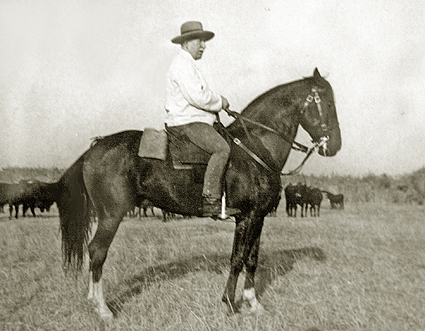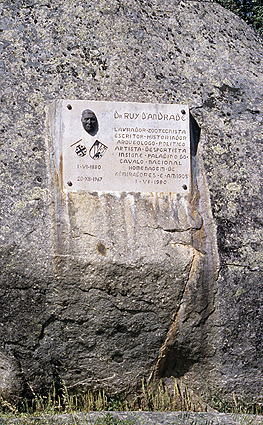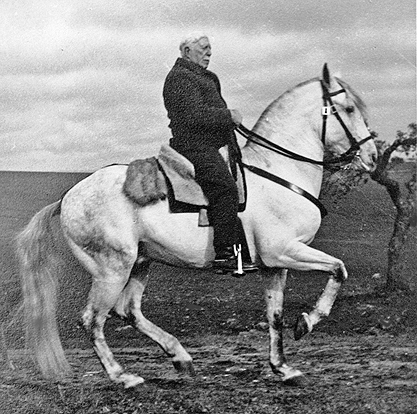Ruy d‘Andrade

Ruy d'Andrade is first and foremost remembered by most as a horse expert, as Portugal's greatest equestrian authority. However, he was much more. In Alter do Chão, on the premises of the former Royal Stud, where that special branch of Portuguese horses was created and bred over the centuries, the "Alter Real", a memorial stone was erected in Ruy d'Andrade's honor, which remembers him as:
"DR RUY D'ANDRADE
AGRARIAN, ZOOLOGIST, AUTHOR, HISTORIAN, ARCHEOLOGIST, POLITICIAN, ARTIST, DISTINGUISHED SPORTSMAN, DEFENDER OF THE NATIONAL HORSE – A TRIBUTE FROM ADMIRERS AND FRIENDS"

Dr. Ruy d'Andrade was born June 1, 1880 in Genoa, Italy. His father was Portuguese, his mother Italian. He was a member of the Portuguese parliament, a committed monarchist, and was in fact the last Mayor of the town of Elvas before the revolution and the overthrow of the monarchy in 1910. Ruy d'Andrade stood out as an academic, his political and theoretical research in agronomy lead to his doctoral thesis in Agricultural Sciences at the University of Paris. He also was a doctor of agronomic science in Pisa, Italy, and received the title of Doctor honoris causa from the University of Madrid.
He conducted some pioneering experiments in the modernization of Portuguese agriculture on his estate Font'Alva at Barbacena. During the first two years of the revolutionary regime, Dr. Ruy d'Andrade and his father Alfredo d'Andrade, as well as their property and their servants, were victims of the excesses of the militant dictatorship, which led to the occupation of their land and the burning of their crops. This hardship lasted nearly four years.
Ruy d'Andrade wrote and published several reference works: "The Andalusian Horse" (1937), "Garranos" (1938), "Elements of the History of the Stud of Alter" (1947 - 1959), plus minor agricultural works, which are available in the Lisbon National Library.
In 1920 he was hunting in a former Royal hunting area near Coruche, which at that time was a region under "Sesmaria" law, comparable to the English "commons", which was designed to encourage civilization and cultivation of wilderness areas. On that hunting trip he happened on a herd of wild horses that made a lasting impression on him. In the following years he recognized traits of those horses in many Andalusian and Lusitano horses (the two breeds were not treated separately back then), which convinced him that what he had come across on that hunting trip had been the last remnants of the wild ancestor of those breeds. In the late 1920s he started to look for that kind of horses and by 1930 his private life had become settled enough to allow him to embark on a project to preserve this hippological treasure. The wild herd could not be located anymore, but on the properties of the landowners of the area he was able to still find horses with the same characteristics. Those he selected for his preservation program of the horse he named "Sorraia", after the river that runs through that region.
What the area was like can be understood if one considers that even after Sesmaria rule, approx. fourty years later, the forest and the brush there was so dense that "one could talk with the next rider, but one could not see him", as Ruy d'Andrade's oldest grandson Rui related, who had driven cows through the same region back then. In the late 1950s and early 1960s, there were still no fences and cows were driven all through it and all the way to Barbacena. Add to this that the area had been a Royal hunting ground before and it becomes not so improbable after all that some wild horses had survived there that mostly still represented the indigenous wild horse, which used to be known as "zebro".
Ruy d'Andrade's son Fernando had kept the Sorraias, but his heart hadn't been in it. He was mostly concerned with the breeding of Lusitanos and developed the d'Andrade line of Lusitanos to become one of the two major and most famous lines of the breed. The stud had been formed in 1894 by Ruy d'Andrade, with Spanish mares from breeders like Hermanos Guerrero, D. Vincent Romero y Garcia, and D. Antonio Perez Tina, all straight Cartujanos, as well as the stallions he used. Fernando d'Andrade also authored a book on the breeding of fighting bulls. However, when in the second revolution in 1974/75 the Sorraias appeared highly threatened like everything else, he split up the herd and placed some horses with the National Stud at Alter do Chão, some with a friend, Dr Manuel Abecassis, and some with the German Dr Michael Schäfer, whom he had known as interested in these horses. He did this to better the chances that at least some of the horses would survive. The Sorraias of the d'Andrade family were robbed by the mob, but were later discovered at a horse market and could be repossessed. As it turned out, the horses at Alter do Chão and Abecassis survived the revolution as well. Those in Germany were not in danger anyway.

Ruy d‘Andrade doing a piaffe when way over 80 years of age
The Sorraia horse, which is nothing else but what was left from the zebro, is viewed by many if not by most as Ruy d'Andrade's most important legacy. In 1935, Ruy d'Andrade lectured on the Sorraia horse at the XII. International Zoological Congress in Lisbon.
Ruy d'Andrade is also remembered as the savior of the Alter Real breed, which had been all but ruined after the revolution in 1910 and subsequent years. When the Agrigultural Ministry tried to revive the breed in the 1940s, no Alter Real stallions were thought to have survived, and Ruy d'Andrade is credited with having played a crucial part in the ressurrection of the breed by contributing two Alter Real stallions that he had had the foresight to obtain while still possible.
Ruy d'Andrade had dedicated his life to the study of the archeology and history of the Iberian Peninsula and its horse. He died December 20, 1967, in Lisbon, at the age of 87, and had given up horseback riding only a few months before. The family tradition is today perpetuated by his grandchildren, Rui, José Luis, Fernando, and Maria.



